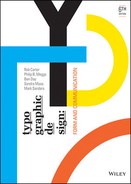FOREWORD
During the late 1970s and early 1980s, I was a youthful assistant professor of graphic design and typography at Virginia Commonwealth University. At that time, typography held special significance in the graphic design curriculum, and faculty spent much effort writing content for the typography courses. With perhaps the exception of Emil Ruder's Manual of Typographical Design, a masterful book based on Ruder's philosophy and typographic instruction during the 1960s at Basel School of Design, my colleagues Philip Meggs, Ben Day, and I could not find a text that moved typography beyond what was generally considered a technical discipline. Our concern was to teach typography as both a technical and theoretical discipline, one that focused on form (syntax) and communication (semantics). Finally, during a meeting sometime in 1982, we made a decision to write our own typography textbook, based on our collections of notes from our classes.
While the three of us shared a passion for typography and a commitment to typographic education, each of us also brought our own unique vision, which produced a synergistic and dynamic interaction. Researching, articulating, and blending ideas did not come easily. During weekends and long into countless nights, we struggled to invent a vocabulary and approach to typographic education that would move the discipline forward and provide students with a text that not only covered basics but also presented information within a much-needed theoretical and historical framework.
Three years later, the first edition of Typographic Design: Form and Communication was published. The book, with its gray cover and elemental TD, was eventually referred to as the “Carter, Day, Meggs” book, or simply “the gray book.” It soon became a classic, one that has inspired, enlightened, and educated thousands of students over thirty years.
I am proud and grateful that my former graduate students Sandra Maxa and Mark Sanders have taken up the mantle of authorship for this, the sixth edition of Typographic Design: Form and Communication. As articulate and committed design educators and practitioners, they have preserved the spirit of previous editions while brilliantly introducing vital new content. Readers who thoughtfully enter into this volume will gain the knowledge necessary for an informed and inspired typographic design practice.
Rob Carter
